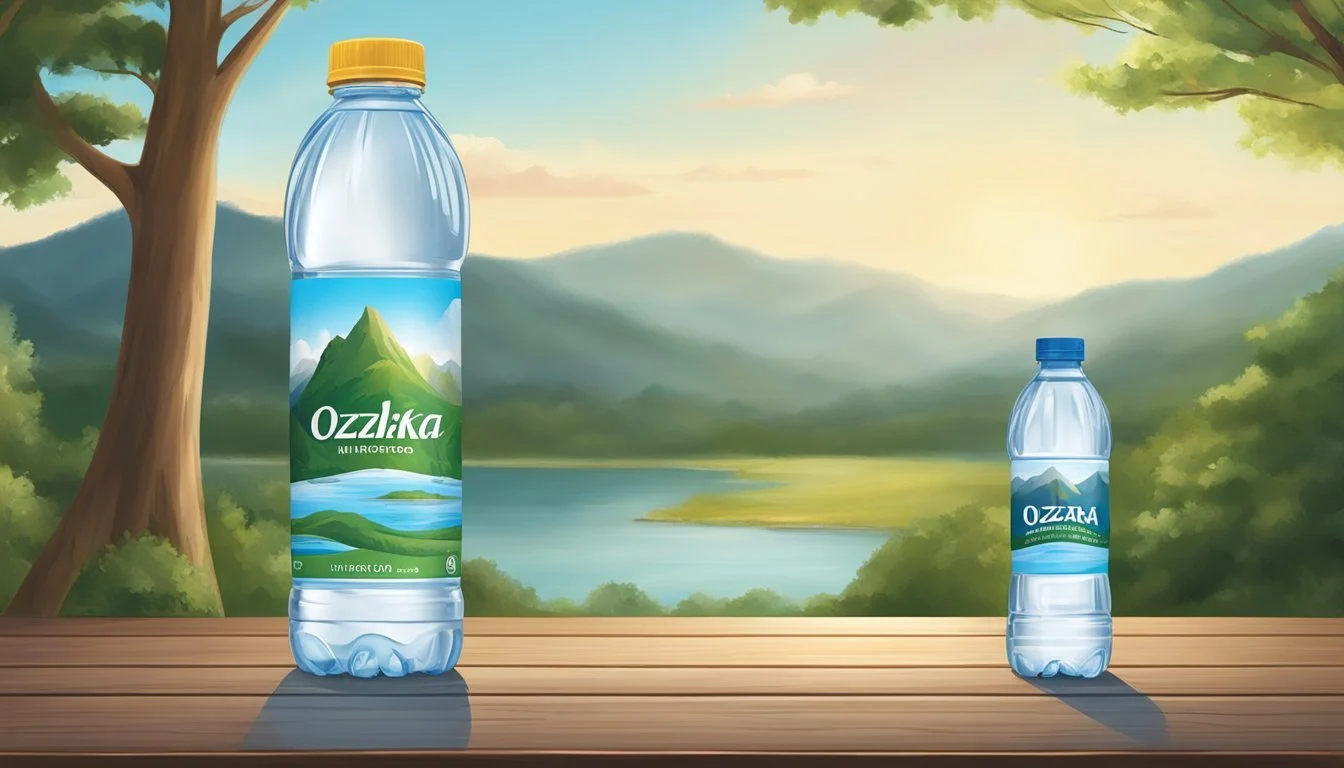Ozarka vs. HFactor
Which Bottled Water is Better for You?
When choosing bottled water, discerning between brands can elevate your hydration experience. Ozarka, sourced from local springs in Texas, prides itself on its natural, regional origins. Its crisp and clean taste reflects the specific geologies of its sources.
HFactor, on the other hand, offers a unique proposition with its hydrogen-infused water, promising enhanced hydration and potential health benefits. This innovative approach seeks to provide more than just quenching thirst but also supporting recovery and performance.
For those prioritizing natural spring water with a regional touch, Ozarka stands out, while HFactor appeals to those looking for cutting-edge hydration technology. Each offers distinct advantages that cater to different consumer preferences.
The Importance of Water in Hydration and Health
Water plays a crucial role in maintaining bodily functions and promoting overall health. Proper hydration supports various physiological processes and enhances well-being.
Understanding Hydration and Bodily Functions
Hydration is essential for the maintenance of bodily functions. Water constitutes around 60% of the human body, aiding in vital processes.
It facilitates digestion, nutrient absorption, and waste elimination. Blood circulation relies heavily on a well-hydrated system. Hydrated cells ensure efficient oxygen and nutrient transport.
Water also regulates body temperature. Sweat, primarily composed of water, cools the body through evaporation. Without adequate hydration, heat regulation becomes impaired.
Health Benefits of Quality Water Consumption
Quality water intake boosts health in numerous ways. It flushes out toxins, reducing the risk of kidney stones and urinary tract infections.
Hydrated skin appears more radiant and elastic, counteracting wrinkles and dryness. Water also aids in weight management by creating a feeling of fullness.
Easily accessible water options like Ozarka and HFactor provide mineral-rich hydration. These minerals, including calcium and magnesium, are vital for bone health and muscle function.
Electrolyte balance is another significant aspect. Proper hydration maintains sodium, potassium, and other electrolytes, preventing cramps and maintaining heart rhythm. Thus, investing in quality water is significant for long-term health.
Bottled Water Industry Overview
The bottled water industry has grown into a booming global market, driven by increasing consumer demand and stringent safety standards.
Market Insights and Consumer Demand
The bottled water market has experienced substantial growth over the past decade. Global sales have surged, attributed to rising consumer concerns over water quality and a preference for convenience.
Consumers gravitate towards bottled water for its perceived purity and taste. Brands like Ozarka and HFactor cater to this demand by emphasizing their unique sourcing and filtration methods. Ozarka, for instance, sources its water from natural springs in Texas.
Innovations such as enhanced mineral water and eco-friendly packaging have also played significant roles in market expansion. Health-conscious consumers prefer bottled water over sugary beverages, further boosting sales.
Regulations and Safety Standards
The bottled water industry is subject to strict regulations to ensure safety and quality. In the United States, the Food and Drug Administration (FDA) enforces standards under the Federal Food, Drug, and Cosmetic Act.
Bottled water must meet rigorous criteria, including regular testing for contaminants. The International Bottled Water Association (IBWA) sets additional benchmarks, promoting best practices among its members.
Compliance with these standards is crucial for maintaining consumer trust. Companies must routinely monitor their products to ensure they meet both federal and industry-specific guidelines. Essential safety protocols include proper sourcing, bottling practices, and accurate labeling, all designed to ensure consumers receive safe, clean water.
Understanding Bottled Water Quality
Key aspects of bottled water quality include standards for purity, pH levels, mineral content, contaminants, and the specific processes used in filtration and purification.
Assessing Water Quality Standards
Water quality standards are crucial for ensuring that bottled water is safe for consumption. Each brand must comply with guidelines set by regulatory bodies like the FDA in the United States.
These standards cover parameters such as microbial contamination, chemical levels, and physical properties. Consistency in meeting these standards indicates reliable quality. Regular testing and certification by independent labs add an extra layer of trust for consumers.
Significance of pH Levels and Mineral Composition
pH levels and mineral composition play a vital role in determining the taste and health benefits of bottled water. The pH level of water, typically ranging from 6.5 to 8.5, affects its acidity or alkalinity.
Mineral content, including calcium, magnesium, and potassium, contributes to the water’s overall flavor and nutritional value. Brands often highlight their unique mineral content to differentiate themselves in the market.
Impurities and Contaminants in Water
Impurities and contaminants in water can significantly impact its safety and quality. Common contaminants include bacteria, heavy metals, and chemical pollutants.
Understanding the sources of these impurities, such as environmental pollution or inadequate filtration, is essential. Brands often undergo rigorous testing to certify the absence of harmful substances, offering peace of mind to consumers.
Filtration and Purification Processes
The methods used for filtration and purification can vary greatly among bottled water brands. Common techniques include reverse osmosis, distillation, and UV treatment.
Each process targets different impurities and levels of filtration effectiveness. An understanding of these methods helps consumers make informed decisions about which brand aligns with their preferences for purity and taste.
Comparing Ozarka and HFactor
Ozarka and HFactor represent two distinct approaches to bottled water, each catering to different consumer needs. This section explores brand histories, taste profiles, purity, and the health and environmental implications of both brands.
Brand Histories and Water Sources
Ozarka traces its roots back to 1905 and sources its water primarily from natural springs in Texas. Its regional focus ensures local sourcing, contributing to its fresh taste and reduced transportation footprint.
HFactor, a newer entrant, markets itself around hydrogen-infused water. Sourcing filtered water and infusing it with molecular hydrogen aims to offer potential health benefits. Unlike traditional spring water, HFactor’s process involves sophisticated technology, setting it apart from conventional bottled water brands.
Taste Profiles and Consumer Preferences
Ozarka’s water is known for its clean and crisp taste, thanks to its natural spring sources. It maintains a neutral to slightly alkaline pH, which most consumers find refreshing.
HFactor has a unique taste due to its hydrogen infusion. Some consumers report a smooth, almost silky mouthfeel with minimal aftertaste. The novelty of hydrogen-infused water attracts health-conscious individuals and those seeking a distinct hydration experience.
Purity and Mineral Content Analysis
Ozarka prides itself on its spring water's natural purity. Minimal processing ensures that the water retains essential minerals, like calcium and magnesium, providing a balanced mineral content that contributes to its fresh taste.
HFactor undergoes a different purification process, focusing on eliminating impurities before hydrogen infusion. While it might lack the natural mineral content found in spring water, its purity levels meet stringent standards, ensuring a clean, contaminant-free product.
Health and Environmental Impact
Ozarka’s local spring sources support lower carbon emissions due to reduced transportation needs. However, being a single-use plastic bottle brand, it does contribute to plastic waste, making recycling an important consideration for consumers.
HFactor positions itself as a health-centric product, marketing hydrogen's potential antioxidant benefits. Environmentally, it uses recyclable materials for its packaging. The added technology for hydrogen infusion might have a higher energy footprint, but it emphasizes sustainability through responsible packaging choices.
By understanding these aspects, consumers can make informed decisions about which water brand aligns better with their preferences and values.
Sustainability and Environmental Considerations
When comparing Ozarka and HFactor, it is essential to analyze their commitment to sustainability, eco-friendly packaging, water sourcing practices, and overall environmental impact. Understanding these factors can help consumers make more informed choices about their bottled water preferences.
Eco-Friendly Packaging and Recycling
Ozarka primarily uses plastic bottles, which raises concerns about environmental waste if not properly managed. While plastic is often criticized for its environmental footprint, Ozarka has made efforts to use recycled plastic in its packaging, though the extent of this effort can vary.
HFactor, on the other hand, markets itself as having a more eco-friendly approach, using flexible pouches that are claimed to require less plastic than traditional bottles. These pouches are often made from materials that are easier to recycle, adding a layer of sustainability.
Recycling plays a crucial role in minimizing the impact of both products. Consumer participation in recycling programs greatly influences the effectiveness of these efforts. While both brands promote recycling, widespread consumer compliance remains a key factor in successfully reducing their environmental footprint.
Water Sourcing and Its Environmental Impacts
Ozarka sources its water from various natural springs. This method can have multiple environmental implications, such as potential impacts on local ecosystems and water tables. The company claims to manage these sources sustainably, but such practices often require rigorous oversight to ensure minimal environmental disruptions.
HFactor sources hydrogen-infused water, a process that also involves environmental considerations. The extraction and infusion processes need to be scrutinized for their sustainability. While detailed information on HFactor's sourcing is less publicly available, the brand emphasizes its innovative approach to hydration and sustainability.
Both companies must address concerns related to over-extraction and the potential depletion of natural resources. Transparent reporting and adherence to environmental guidelines play a significant role in mitigating negative impacts.
Brands' Sustainability Efforts
Ozarka is part of Nestlé Waters North America, which has announced significant sustainability goals. These aims include increasing the use of recycled materials and reducing carbon emissions. Their initiatives often highlight partnerships with various recycling organizations and communities to bolster their eco-friendly image.
HFactor champions sustainability by focusing on the reduced plastic use and promoting eco-conscious living. The brand's flexible pouches are a testament to its commitment to reducing packaging waste.
Both brands stress their respective eco-friendly measures, yet the effectiveness and implementation of these initiatives can fluctuate. Active participation in environmental efforts and continuous improvement in sustainability practices are critical for both Ozarka and HFactor to minimize their environmental impact.
Consumer Choices in Bottled Water
When deciding between bottled water brands like Ozarka and HFactor, consumers weigh multiple factors, including brand reputation, the type of water, and packaging convenience.
The Role of Brand in Purchasing Decisions
Brand reputation plays a significant role in consumer choices. Ozarka is noted for its locally sourced Texas spring water, which appeals to those who value natural and regional products. HFactor, on the other hand, markets itself as a hydrogen-infused water brand aimed at health-conscious consumers. Brand identity, often reinforced by marketing efforts and consumer reviews, heavily influences purchasing behavior.
Types of Water: Spring, Sparkling, Alkaline, and More
The type of water is another critical factor. Ozarka offers spring water, harvested directly from natural springs, appealing to those seeking pure, fresh-tasting hydration.
In contrast, HFactor specializes in hydrogen-infused water, which claims to provide added health benefits like improved recovery and reduced inflammation. Consumers may also consider other water types like sparkling or alkaline based on their personal taste and health preferences.
Packaging and Convenience Factors
Packaging and convenience are crucial to many consumers. Bottled waters like Ozarka often come in various sizes, making them suitable for different needs, from large family packs to single-serve bottles. HFactor distinguishes itself with unique packaging designed to preserve hydrogen content.
Packaging materials, such as whether the bottle is plastic or glass, and features like reusability or portability, also influence consumer decisions. Easy-to-carry bottles are particularly popular for active lifestyles.
More About Ozarka
Mountain Valley Spring Water vs Ozarka: Which Bottled Water is Better?
Ozarka vs Kirkland Signature: Which Bottled Water is Better?
Ozarka vs Richard's Rainwater: Which Bottled Water is Better?
Ozarka vs Whole Foods Italian Still Mineral water: Which Bottled Water is Better?
More About HFactor
Whole Foods Italian Still Mineral water vs HFactor: Which Bottled Water is Better?
Richard's Rainwater vs HFactor: Which Bottled Water is Better?
Mountain Valley Spring Water vs HFactor: Which Bottled Water is Better?
Kirkland Signature vs HFactor: Which Bottled Water is Better?
Icelandic Glacial vs HFactor: Which Bottled Water is Better?





